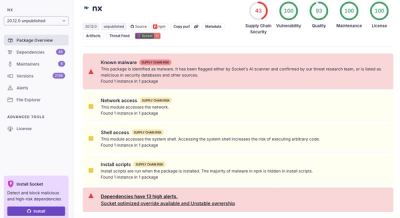
Security News
Risky Biz Podcast: Making Reachability Analysis Work in Real-World Codebases
This episode explores the hard problem of reachability analysis, from static analysis limits to handling dynamic languages and massive dependency trees.
@karmaniverous/edge-logger
Advanced tools
A simple logging class that renders nicely-formatted logs and plays nicely with edge networks.
The Next.js Edge Runtime is extremely limited as to the packages it can load.
This can pose a challenge for common logging and utility packages like winston and lodash, which will fail when loaded into an edge resource.
Logging is a cross-cutting concern, and shouldn't have to care where it is executed. So this package is a simple, flexible logging utility that...
npm install @karmaniverous/edge-logger
import Logger from `@karmaniverous/edge-logger`;
const logger = new Logger();
logger.emerg('emergency message', { foo: 'bar' }); // rendered with console.error()
logger.alert('alert message'); // rendered with console.error()
logger.crit('critical message'); // rendered with console.error()
logger.error('error message'); // rendered with console.error()
logger.warning('warning message'); // rendered with console.warn()
logger.notice('notice message'); // rendered with console.info()
logger.info('info message'); // rendered with console.info()
logger.debug('debug message'); // rendered with console.debug()
logger.log('log message'); // rendered with console.info()
// emerg: emergency message
// emerg: {
// emerg: "foo": "bar"
// emerg: }
// alert: alert message
// crit: critical message
// error: error message
// warning: warning message
// notice: notice message
// info: info message
// info: log message
// debug level not rendered by default.
// Set LOG_LEVEL to 'debug' to see these.
Set your minimum logging level with environment variable LOG_LEVEL (by default it is info).
The optional constructor config argument has the following keys:
| Key | Description |
|---|---|
defaultLevel | Default logging level (invoked by the log method). Default value set in levels object (info for default levels). |
maxLevel | Maximum logging level. Default value set in levels object (info for default levels). |
levels | An alternate levels definition. See below for details. |
Here is the default levels object:
{
emerg: { value: 0, console: 'error' },
alert: { value: 1, console: 'error' },
crit: { value: 2, console: 'error' },
error: { value: 3, console: 'error' },
warning: { value: 4, console: 'warn' },
notice: { value: 5, console: 'info' },
info: { value: 6, console: 'info', default: true, defaultMax: true },
debug: { value: 7, console: 'debug' },
}
Each key will be rendered as a function on the Logger instance that takes a list of items, just like console.log().
The keys on each log level:
| Key | Description |
|---|---|
value | Supports setting the logging threshold. |
console | The console function invoked by the log level. |
default | true if the log method should trigger this level. |
defaultMax | true if default max level. |
See more great templates and other tools on my GitHub Profile!
FAQs
A simple logging class that renders nicely-formatted logs and plays nicely with edge networks.
We found that @karmaniverous/edge-logger demonstrated a not healthy version release cadence and project activity because the last version was released a year ago. It has 0 open source maintainers collaborating on the project.
Did you know?

Socket for GitHub automatically highlights issues in each pull request and monitors the health of all your open source dependencies. Discover the contents of your packages and block harmful activity before you install or update your dependencies.

Security News
This episode explores the hard problem of reachability analysis, from static analysis limits to handling dynamic languages and massive dependency trees.

Security News
/Research
Malicious Nx npm versions stole secrets and wallet info using AI CLI tools; Socket’s AI scanner detected the supply chain attack and flagged the malware.

Security News
CISA’s 2025 draft SBOM guidance adds new fields like hashes, licenses, and tool metadata to make software inventories more actionable.